
Cathar country
Medieval heritage in the south of France
- Explore France ►
- Essential pages
- Travel in France
- Where to go
- What to see and do
About-France.com
- the connoisseur's guide to France
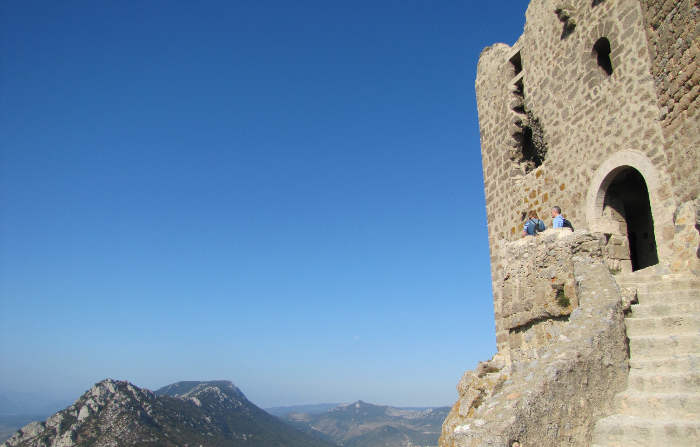
The
castle at Quéribus
What
and where is "le Pays Cathare", and who were the Cathars?
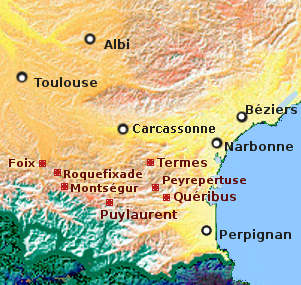
Map
of Cathar country, showing main towns and main Cathar castles
The "Cathars" themselves were not a race, or a people; they were the followers of a dissident church that flourished in several parts of Europe during the early Medieval period.
Catharism - meaning litterally purity (as in catharsis) - was a sort of proto- Protestantism that promoted values of equality, neighbourliness and charity, and turned its back on the pomp, hierarchy and worldly wealth of the Catholic church of the time. Cathars believed that Earth was ruled by a malevolent God, and that Heaven was the world of the good God: this dualist concept of God was not unique to Catharism, but it was sufficient cause for the Catholic church of the time to brand Catharism as a heresy.
Catharism did not have a founder, nor a designated leader, and it did not only take root in one place. It appears to have originated in the Byzantine world, and to have spread to Europe via churches in Bulgaria. By the eleventh century, there were Cathar believers all over Europe, including England. But one of the places in which the Cathar church really flourished, and the place with which the word Cathar is now strongly associated, is the southern half of the French region of Occitanie (Languedoc and Midi-Pyrénées).
Cathars and Languedoc
In the early Middle Ages, France was a much smaller country than now; the area that is France today was then a hotchpotch of kingdoms, duchies and counties, some with allegiance to the French crown, others with different loyalties. "Languedoc" was the generic name given to the southern half of the country, where they did not speak French at all, but a family of languages between French and Spanish known as "les langues d'oc", or Occitanian. Some areas in this "Occitania" were largely independent, others belonged to the Holy Roman Empire, others - including parts of "Cathar country" to the kingdom of Aragon. Above all, territories in this frontier region astride the eastern Pyrenees far from the power houses of Europe - Paris, London and Rome - changed hands frequently following alliances and power struggles, marriages and deaths, among the local rulers, the most important of whom were the Counts of Toulouse.
As in later centuries, religious dissent was not just a theological statement; it was a way by which local rulers and people could assert their differences and their cultural independence from the great European powers of the day, the Catholic church and the Kings of France.
Thus a large part of the Languedoc, people and nobles, adopted the Cathar heresy, and by so doing distanced themselves from the French and from Rome. By the early 13th century, Catharism had taken such a strong hold in the area, that in 1208 Pope Innocent III launched the notorious Albigensian Crusade - a crusade aimed not against the Infidels, but against the "heretical" Cathars. For twenty years, crusaders, led by the Barons of France including Simon de Montfort, Earl of Leicester, sacked and pillaged the area, massacring Cathars or converting them by force to Catholicism. In the early 1220s, the Cathars' fortunes revived, prompting a second wave of Crusading this time led by King Louis VIII and later Louis IX. Finally, most of the area was subjugated, and in 1229, the Treaty of Meaux-Paris was signed, bringing almost the whole of Occitania into the realm of the French crown. Pockets of Cathar resistance held out for the next twenty-six years.
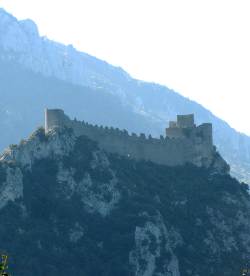
Impregnable Puylaurent
The Albigensian Crusade has been described as the first act of genocide in Europe, though this is surely an exaggeration; medieval wars were cruel, and acts that would be classed today as crimes against humanity, were in those days part and parcel of the strategy of conquest. The castle at Montségur remained a Cathar stronghold until 1244, when it was finally taken and 200 Cathar prisoners taken were burned alive. The last Cathar stronghold, the Chateau de Peyrepertuse, fell in 1255.
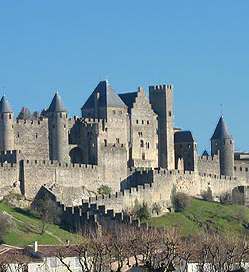
Carcassonne, another great Cathar citadel
In order to consolidate their power, the new French masters of Languedoc rebuilt and maintained the fortified cities and the great defensive castles of the area. They strengthened the defences of walled cities like Carcassonne and Narbonne, and renovated most of the imposing strongholds that they had captured, as at Quéribus, Peyrepertuis, or Puylaurent. They even built the massive fortified cathedral at Albi, as a high-powered statement of Catholic dominance - and fear of revolt - in the area. And because Languedoc was for the next six centuries largely a peripheral area in terms of European development, a lot of these medieval monuments have come down through time relatively intact.
In human terms, historians estimate that the persecution of the Cathars in Languedoc caused half a million deaths. In cultural terms, the suppression of the Cathar heresy and the consolidation of French power in Occitania led to the strangling of of one of the great cultures of medieval Europe. However most people in the area continued to speak forms of Occitanian until well into the nineteenth century, and Occitanian languages are still alive as patois even to this day. In recent years,; and since the 1970s, the concept of "Oc" - and with it the memory of the Cathars - has staged a strong revival, even to the point that in 2016, the people in the new French region formed from the merging of the Languedoc and Midi-Pyrenees regions voted to revive the name "Occitanie" as the name of the new region. Even so, the flame of Occitanian literature and culture, snuffed out in the 13th century by the imposition of a nobility answerable to the crown of France, has never been seriously rekindled .
Getting to Cathar country :
- Distance from Paris: 800 km by road .
- Best Routes to the south of France
- Main cities: Narbonne, Béziers, Carcassonne, Perpignan
- Main railway stations: Béziers, Narbonne, Perpignan - all served by TGV from Paris. Rivesaltes, near Perpignan, for the start of the Cathar country scenic railway. Click here for train information for France
- Regional airports: Perpignan, Carcassonne.
Copyright
© About-France.com except where otherwise stated.
About-France.com
Home
page - Site
search
- Regions
- Maps of France
- Contact
Photo
top of page: View out from the impregnable fortress at Quéribus
Cathar
Country - Le Pays Cathare
Forty years ago, nobody had heard of "Cathar country"; that was not surprising, since the term had not yet been coined. The term "Cathar country" was first used by the tourist service of the Aude department of southern France, to create a coherence between many of the remarkable local historic monuments, that had witnessed the sieges and massacres that marked the area's turbulent history in and around the twelfth and thirteenth centuries.
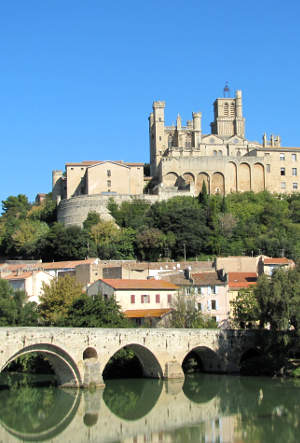
Béziers - site of a terrible massacre of Cathars in 1209
Accommodation
in the area of Cathar country
About-France.com
is an independent user-supported website
that does not track visitors and carries very little advertising, Links
to carefully selected affiliate partner websites may generate
commission on sales at no cost to the user.
Cathar country tours
For top-rated historical tours of Cathar Country, check out catharcountry.info.Included are both private and scheduled tours of Cathar related sites throughout the year, including Carcassonne, Montsegur and over 40 others historic locations.
The best of France
by theme- Prehistoric France
- Roman France - the best sites
- Best medieval cathedrals
- Great medieval fortresses
- Renaissance and classic châteaux
- Loire
valley châteaux
- The best art galleries and museums in France
- Industrial and transport museums
- Scenic railways and steam railways
- First world war sites and memorials
- The French coast and beaches
- Wine regions of France
- Beautiful villages in France
Click here for
low-cost car hire in France
low-cost car hire in France
Texts and photos copyright About-France.com renewed 2025
